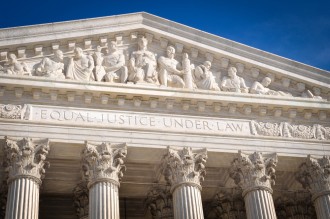
January 22, 2015
Supreme Court Endorses De Novo Review of Claim Construction, But Holds that Subsidiary Facts Underlying Claim Construction are Reviewed for Clear Error
Background: Patent claim construction findings are a key aspect to patent infringement cases. Previously, the Federal Circuit reviewed the entire claim construction issue, including any subsidiary facts, de novo.
Holding: While the ultimate claim construction remains reviewable de novo, the Federal Circuit must accept any subsidiary findings in the claim construction unless those findings are clearly erroneous. This will make it more difficult to overturn claim constructions that rely upon extrinsic evidence, although it should have no effect on constructions relying solely upon intrinsic evidence.
Discussion: In Teva Pharmaceuticals USA, Inc. v. Sandoz, Inc., No. 13-854 (January 20, 2015), the Supreme Court held that while the ultimate question of claim construction remains a legal question subject to de novo review, the district court’s subsidiary fact determinations are no different than any other factual determinations which under F.R.C.P. 52(a)(6) are reviewed for clear error. Teva and Sandoz disputed the meaning of the claim requirement “a molecular weight of 5 to 9 kilodaltons.” The “molecular weight” could be determined by at least three different methods, and the patent did not explicitly state which method should be used. Sandoz argued that this made the claims fatally indefinite, but after considering conflicting expert testimony from the parties, the district court concluded that the claim was sufficiently definite, and thus valid. The Federal Circuit reviewed the entire question of claim construction stating “[o]n de novo review of the district court’s indefiniteness holding, we conclude that [Teva’s expert’s] testimony does not save Group I claims from indefiniteness.”
The Supreme Court saw no reason to treat subsidiary factual findings relating to an issue of law any different from any other factual findings subject to review for clear error under F.R.C.P. 52(a)(6). The Supreme Court found that when the Federal Circuit did not accept Teva’s expert’s explanation as to how a skilled artisan would interpret the curves in the patent specification, it failed to make a determination that the district court’s determination was clearly erroneous. The Supreme Court said that the Federal Circuit should have accepted the district court’s determination unless it was “clearly erroneous.” In the context of claim construction, these “subsidiary facts” are those findings of fact based upon the district courts’ consideration of extrinsic evidence.
The net impact on claim construction review may not be significant, however, except in cases where there are subsidiary findings of fact. The Supreme Court conceded that when a district court reviews only evidence intrinsic to the patent (the patent claims and specifications, along with the patent’s prosecution history) “the judge’s determination will amount solely to a determination of law, and the Court of Appeals will review that construction de novo.” It is only in those cases where the district court makes factual findings, for example what a particular term means to a person of ordinary skill, that that the clearly erroneous standard will have any impact. As the Supreme Court noted, after making such a factual determination, the district judge will then interpret the patent claim in light of the facts as he or she found them. This ultimate interpretation is a legal conclusion. The appeal court can still review the district court’s ultimate construction of the claim de novo, but to overturn the district court’s resolution of an underlying factual dispute, the Court of Appeals must find that the judge made a clear error.
Given the Supreme Court’s continued support for de novo review of claim constructions based upon the intrinsic evidence, it is only when extrinsic evidence is presented that subsidiary fact findings would arise. The Federal explained in Phillips, that while extrinsic evidence can shed useful light on the relevant art, it is less significant than the intrinsic record in determining the legally operative meaning of claim language. In the specific case of extrinsic expert testimony, the Federal Circuit explained in Phillips that a court should discount any expert testimony “that is clearly at odds with the claim construction mandated by the claims themselves, the written description, and the prosecution history, in other words, with the written record of the patent.” Thus while the Federal Circuit cannot reject a factual finding by the district court unless it is clearly erroneous, in the Phillips framework of claim construction the effect given that factual finding is still well within the control of the Federal Circuit.



































